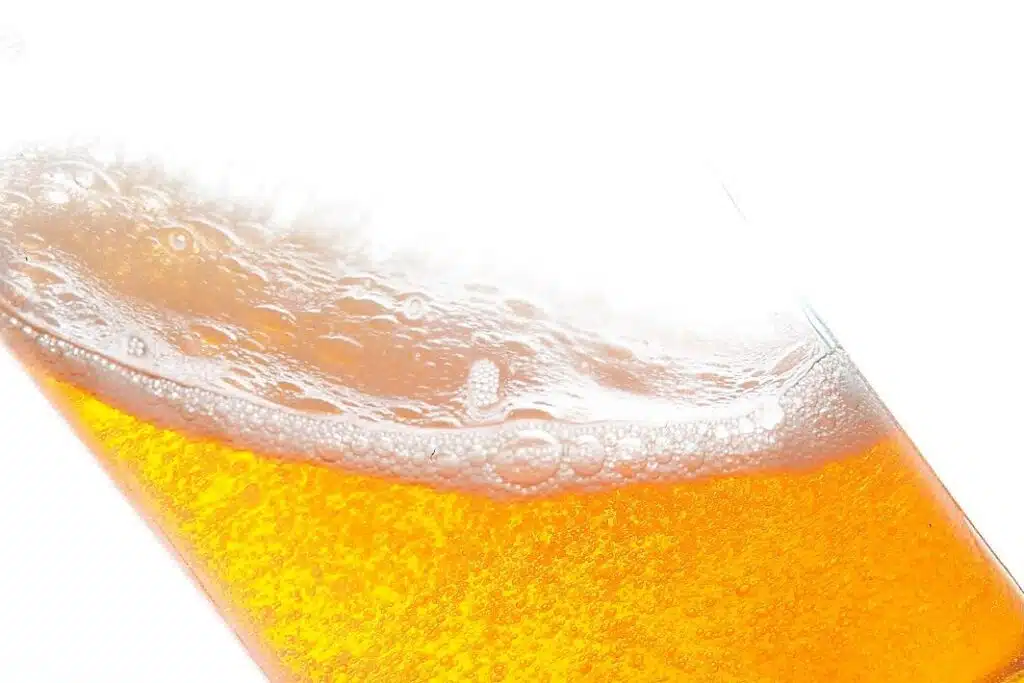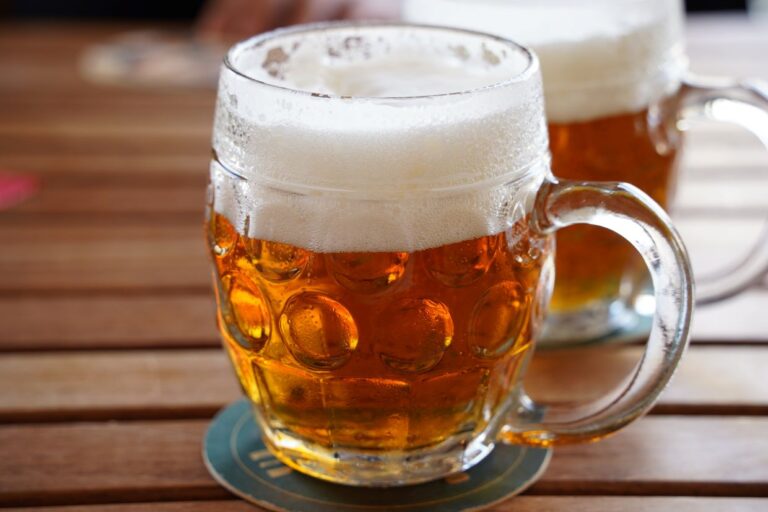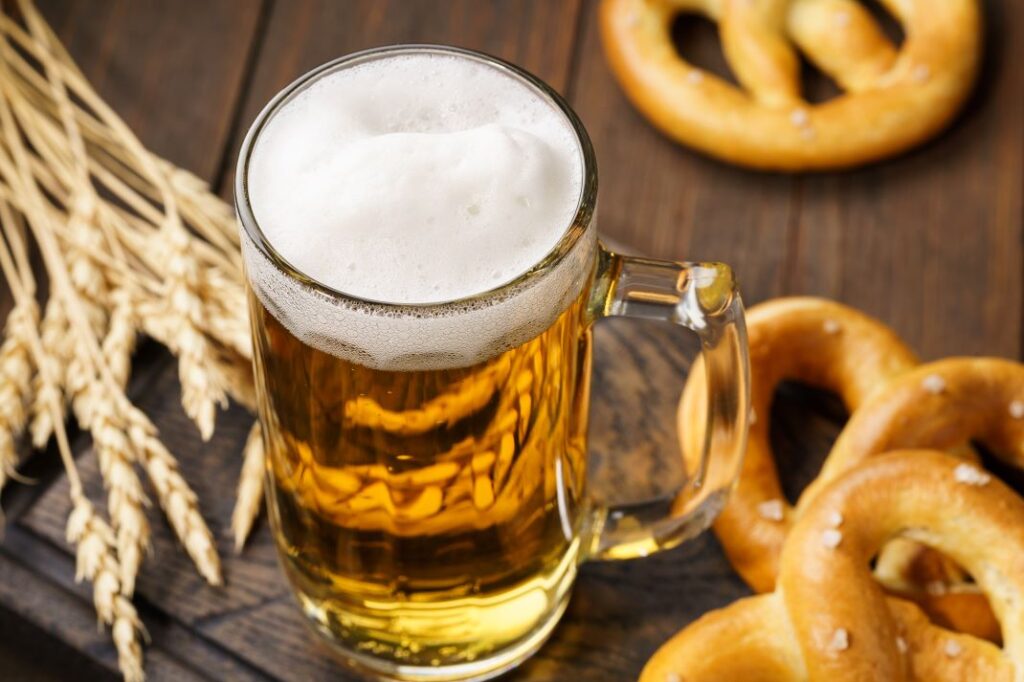
Lager in English, but also Helles in German, Blonde in Italian, Pilsner in Czech… quite a few names for what is considered the king of beers! Certainly, the worldwide best-selling, probably the most delicate in flavour and certainly the most refreshing of all beers. The first sip of this beer is so special that a French writer, Philippe Delerm, inspired by this beer style, entitled his best-selling book “The First Sip of Beer and Other Pleasures“, to remind us that taking the time to appreciate and take pleasure from small, sometimes trivial things is important for our well-being and not a waste of time.
For me the first sip of lager is something always memorable. For example in summer, when I come home from the beach of Rome in the late afternoon after a refreshing shower, I sit down on the balcony relaxing and enjoying the Roman breeze that locals call Ponentino. Pure freshness, both the beer and the chilly wind! Bubbles awaken every part of the body, right down to the toes. That’s when I realise how important is to appreciate the small pleasures that life gives us.

Lager is one of my favourite beers in summer. In my journey, after being a bit confused in recognising how many types of beer belong to this style, I found my way and chose the one I prefer. In this Blog post I look at the main beers belonging to lager style, highlighting the commonalities but also the main differences, so that you too can choose your favourite one.
Lager means “to store” in German and in fact all these beers are stored for a few weeks at fridge temperatures, after fermentation. It is not just a matter of having the beer ready to drink straight from the tank, but the temperature is part of the technology to develop the right flavours in the beer.
Lagers are also called bottom-fermenting beers, mainly for two reasons: they ferment at a low temperature (normally between 8 and 11 C) and the yeast precipitates at the bottom of the fermentation tank while fermentation is still taking place. The type of yeast and low fermentation temperature do not allow the formation of fruity aromas during brewing. That is why lagers have a rather neutral flavour.
About 90% of all beers produced worldwide are lagers. However, the origin of this beer style lies in Germany and Czech Republic, where the lagering storing technique was invented by a wise Benedikt monk.
Contrary to what one might think, because of its delicate flavour, it is not an easy beer to brew and any small mistake could cause an unpleasant taste and make the beer undrinkable. Choosing the best ingredients, particularly water, and keeping attention to detail is what is most required of master lager brewers.


The main Lager styles
The types of beer in lager styles are many. However, the list here represents the main traditional ones.
Pilsner, originally from Pilsen in the Czech Republic, is pale gold in colour. It is crisp and the bitterest of all traditional lagers, with a very distinctive hop aroma. Nowadays it is brewed everywhere and Pils is the correct way to call it when it is not produced in countries other than the Czech Republic.
✔ Choose Pilsner if you like a bitter hop taste and a crisp sensation.
Helles, is a traditional beer brewed in southern Germany, mainly in the Munich area. In contrast to the Pilsner style, this beer has a very low level of bitterness. It is very malty and therefore slightly sweet, which gives a full-bodied feeling.
✔ Helles is definitely the lager style for you, if you like a low level of bitterness and a more malty flavour,
Bock is also a traditional German beer, originating in Saxony, almost in the centre of Germany. It is a light and dark beer (dark colour is also possible for lagers), characterised by a high alcohol content of 6 to 13%. It was brewed on religious holidays such as Christmas and the Benedikt monks (also them) brewed it in the 40 days before Easter. The higher alcohol and richness of flavour made this beer a substitute for fasting before Easter.
✔ Bock is the beer for you if you like your beers high in alcohol, malty rather than hopped, and… if you want to replace a meal with liquid food!
Dortmunder is a lager with a golden colour and rather high alcohol content (between 5 and 6%). It is malty and not very bitter, so it is a beer that lies somewhere between the Helles and Pilsner styles. Another beer served as ‘food’, as it was originally brewed for miners in the Dortmund area, to quench their thirst but also to reward them with the energy provided by alcohol and a full-bodied beer.
✔ The Dortmunder is the beer for you if you like a balanced taste but still want to have a good alcohol content.
The list of lagers is quite extensive and also includes American lagers, originally brewed in the United States by German immigrants and characterised by a low degree of bitterness and produced using not only malts, but also rice and corn. Craft brewers did not produce lagers for a long time, perhaps thinking that the beer tasted too neutral. However, now the trend is on and craft lagers each have something special.



pale gold, fizzy, bitter with a very characteristic hop flavour
very low bitterness, malty, slightly sweet, full-bodied flavour
light and dark beer, full of flavour, malty instead of hoppy
malty and not very bitter, balanced flavour, good alcohol content
low bitterness, very light in flavour
Helles with sausages, birra bionda with pizza, lager with fish and chips or barbecue are the best classic pairings one might immediately think of. However, lagers can be well associated with a range of other foods. Since this style of beer is delicate in flavour, the food to accompany it must be equally delicate in taste.
I explored this beer style with good food and found that it goes very well with some light cheeses such as mozzarella, burrata and goat cheese. It also goes very well with a classic of Roman gastronomy, that is pizza stuffed with mortadella (Mortazza in Roman dialect). The malty taste and bubbles go perfectly with any fried and crispy food. Since beers are great to start a meal as an appetizer, I share my love for this beer with Tzatziki, the Greek yoghurt-based sauce spread on bread. I love it in the summer and lager beer goes perfectly with it, especially if you are in the Mediterranean sun on the Greek islands.
As with other beer styles, I prefer beers that are not extreme in terms of bitterness, sweetness, maltiness, etc. Therefore, my preference is for well-balanced lagers, in which both malts and hops can be tasted distinctly, and which contain moderate amounts of alcohol, because this is beer for the summer. Well, this is exactly the description of Fermento Golden Breeze, which we brew for taste and refreshment. And that is why we chose the name Golden Breeze, because it refers precisely to that refreshing Roman wind that I enjoy with my beer after a day at the beach.
And now close your eyes and take a long sip of your favourite lager beer, to appreciate life’s pleasures, starting with the small and memorable ones,
as I do with a cool beer after a day at the beach, or sitting in a restaurant with some Tzaziki on bread or simply with great friends in a bar.
Now you know which beer to choose to satisfy your pleasure.